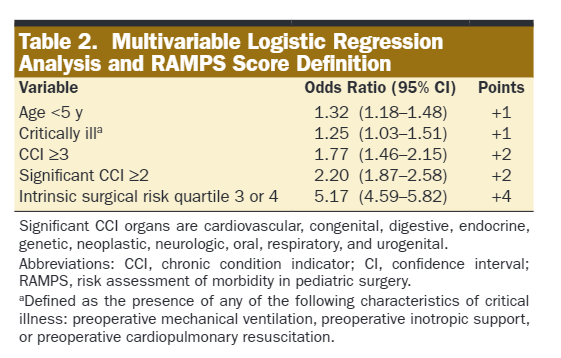RAMPS and Risk
By Myron Yaster
Nasr VG, Valencia E, Staffa SJ, Faraoni D, DiNardo JA, Berry JG, Leahy I, Ferrari L. Comprehensive Risk Assessment of Morbidity in Pediatric Patients Undergoing Noncardiac Surgery: An Institutional Experience. Anesth Analg. 2020 Nov;131(5):1607-1615. PMID: 33079885
An everyday experience for every pediatric anesthesiologist is to assess risk in pediatric patients undergoing surgery. The ASA Physical Status classification has been used to characterize this risk but lacks precision and specificity, is based on adults (recently updated by one of the authors of this paper Lynn Frerrari), and has terrible inter-rater reliability. The National Surgical Quality Improvement Program (NSQUIP) is an online tool that provides empirically derived patient-specific postoperative risk but is based on a tool that has never been publicly validated.
Nasr et al report their institutionally developed and tested Risk Assessment of morbidity in pediatric surgery (RAMPS) score which has the ability to identify a high-risk cohort of pediatric patients using a component tool. This is an astonishing piece of work that should be a must read. Before going into some specifics some important caveats. It does not apply to patients with congenital heart disease AND to the very common surgical population of T&As and strabismus surgery because they aren’t included in NSQUIP. The key variables from Table 2 in the paper:
The authors state: “Calculation of the RAMPS score can be used to stratify risk in children having surgery and to direct institutional resource allocation. ICU beds are a highly utilized and costly resource in most institutions. Preoperative risk stratification can be used to identify children likely to require postoperative ICU care before an acute change in physiologic status and decompensation.”
OK, this is really exciting but how should we use the RAMPS score going forward? I’m wondering if this score can be incorporated into the electronic medical record (e.g., EPIC, Cerner, etc.) to see if it works on a much wider scale. There are at least two SPA committees (the quality and safety committee and the informatics committee) and the Wake Up Safe organization that can and should take this up at their next meetings. Since I’m on these committees I’ll bring it forward to see what is possible and will keep you all posted. So stay tuned. Myron Yaster MD
PS: One of Ron Litman’s seminal papers discussed what parents want to hear when discussing the risks and alternatives of anesthesia during the consenting process…I’ll ask the current managers of the PAAD to see if anyone is interested in reviewing it for the important papers of the past update. It would be nice to tie that paper to this current one. MY


